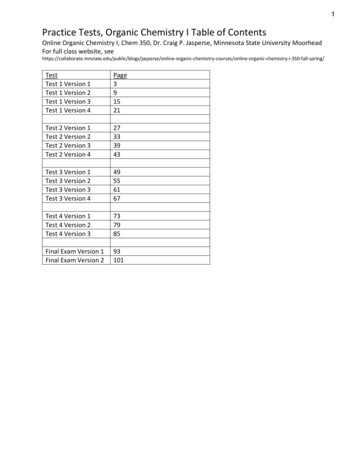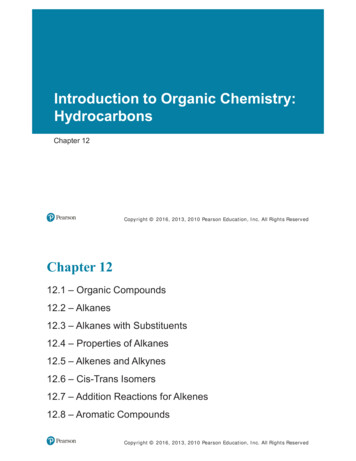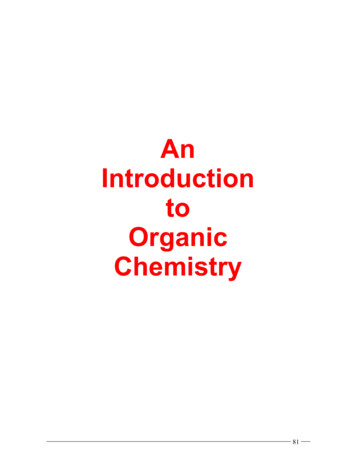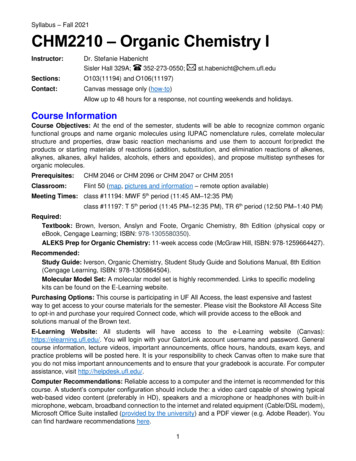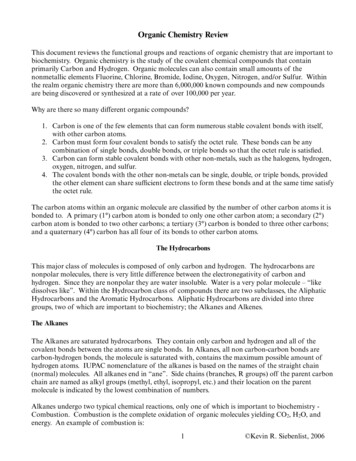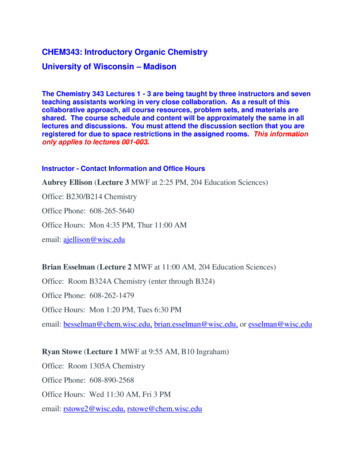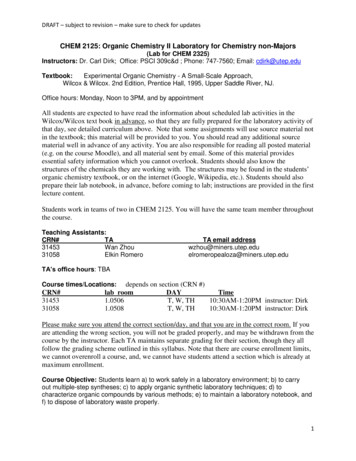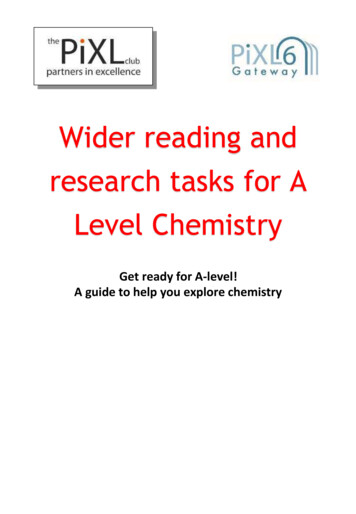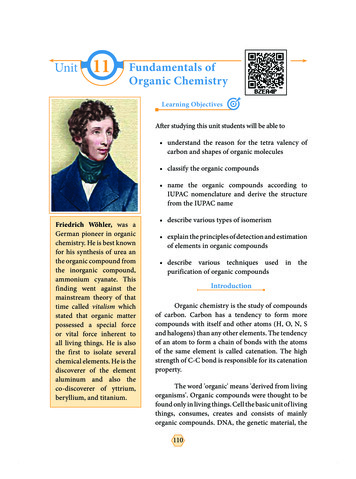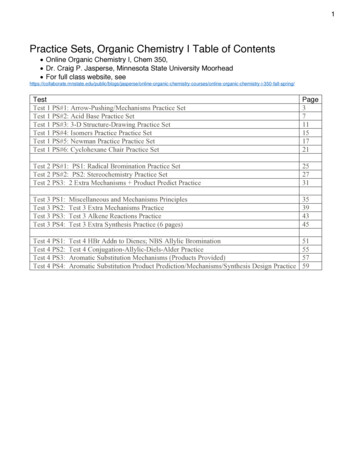
Transcription
1Practice Sets, Organic Chemistry I Table of Contents Online Organic Chemistry I, Chem 350, Dr. Craig P. Jasperse, Minnesota State University Moorhead For full class website, anic-chemistry-i-350-fall-spring/TestTest 1 PS#1: Arrow-Pushing/Mechanisms Practice SetTest 1 PS#2: Acid Base Practice SetTest 1 PS#3: 3-D Structure-Drawing Practice SetTest 1 PS#4: Isomers Practice Practice SetTest 1 PS#5: Newman Practice Practice SetTest 1 PS#6: Cyclohexane Chair Practice SetPage3711151721Test 2 PS#1: PS1: Radical Bromination Practice SetTest 2 PS#2: PS2: Stereochemistry Practice SetTest 2 PS3: 2 Extra Mechanisms Product Predict Practice252731Test 3 PS1:Test 3 PS2:Test 3 PS3:Test 3 PS4:Miscellaneous and Mechanisms PrinciplesTest 3 Extra Mechanisms PracticeTest 3 Alkene Reactions PracticeTest 3 Extra Synthesis Practice (6 pages)35394345Test 4 PS1:Test 4 PS2:Test 4 PS3:Test 4 PS4:Test 4 HBr Addn to Dienes; NBS Allylic BrominationTest 4 Conjugation-Allylic-Diels-Alder PracticeAromatic Substitution Mechanisms (Products Provided)Aromatic Substitution Product Prediction/Mechanisms/Synthesis Design Practice51555759
2
3Test 1 PS#1: Arrow-Pushing/Mechanisms Practice Set1Organic ChemistryJasperseMechanisms Practice. See Page 3 for a summary of mechanisms principles.Arrow-Pushing Practice, Page 1: Draw arrows for each of the steps in the following reactions. I won’t require this on tests, but you may find it useful to include all lone-pairs on atoms thatreact. I won’t require this on tests, but you may find it useful to draw in all hydrogens on atoms thatreact. (It is not useful to draw in all H’s on atoms that don’t react.) Remember that arrows track the movement of electrons, so an arrow should go from the sourceof electrons and point directly to the atom that accepts them.OHO1. H-BrHOH2HHBr2. SN2Br NaI INaBrBr3. E2 HNaOH HHHHOH HH4. SN1NaBrHBrOHOH2O H Br-Br5.HOH2OH2OE1HHH H3OH BrHBr
4Test 1 PS#1: Arrow-Pushing/Mechanisms Practice Set2Page 2: Draw the arrow(s) for each of these steps.OHOH2H 1.OH2 H2O2. H2OH H3O H H3.Br4. OHBrOH5. PhD-BrPh 6. Ph7. Ph OD BrBr BrCH3HDPhOOHHHCH38.OCH3OOCH3Br-ClPh 10. PhBrHH HNEt 3HCH3O9.11. BrPhD BrPhPhBrCl Cl Br H NEt 3PhBr
5Test 1 PS#1: Arrow-Pushing/Mechanisms Practice Set4Some Arrow-Pushing Guidelines1. Arrows follow electron movement.2. Some rules for the appearance of arrows The arrow must begin from the electron source. There are two sources:a. An atom (which must have a lone pair to give)b. A bond pair (an old bond that breaks) An arrow must always point directly to an atom, because when electrons move,they always go to some new atom.3. Ignore any Spectator Atoms. Any metal atom is always a “spectator” When you have a metal spectator atom, realize that the non-metal next to itmust have negative charge4. Draw all H’s on any Atom Whose Bonding Changes5. Draw all lone-pairs on any Atom whose bonding changes6. KEY ON BOND CHANGES. Any two-electron bond that changes (either madeor broken) must have an arrow to illustrate: where it came from (new bond made) or an arrow showing where it goes to (old bond broken)7. Watch for Formal Charges and Changes in Formal Charge If an atom’s charge gets more positive it’s donating/losing an electron pair arrow must emanate from that atom or one of it’s associated bonds. Thereare two “more positive” transactions: When an anion becomes neutral. In this case, an arrow will emanatefrom the atom. The atom has donated a lone pair which becomes a bondpair. When a neutral atom becomes cationic. In this case, the atom will belosing a bond pair, so the arrow should emanate from the bond ratherthan from the atom. If an atom’s charge gets more negative it’s accepting an electron pair anarrow must point to that atom. Ordinarily the arrow will have started from abond and will point to the atom.8. When bonds change, but Formal Charge Doesn’t Change, A “Substitution” isInvolved Often an atom gives up an old bond and replaces it with a new bond. This is“substitution”. In this case, there will be an incoming arrow pointing directly at the atom (toillustrate formation of the new bond), and an outgoing arrow emanating fromthe old bond that breaks
Test 1 PS#1: Arrow-Pushing/Mechanisms Practice Set6
Test 1 PS#2: Acid Base Practice SetOrganic Chemistry Jasperse7Acid-Base Practice ProblemsA. Identify each chemical as either an “acid” or a “base” in the following reactions, andidentify “conjugate” relationships.-You should have one acid and one base on each side-You should have two conjugate pairs1.CH3CH2OH NaOH2.CH3CH2NHLi CH3OH3.CH3CH2CO2H CH3MgBrCH3CH2ONa H2OCH3CH2NH2 CH3OLiCH3CH2CO2MgBr CH4H2O CH3OH2 4. CH3OH H3O5.CH3CH2NH3 CH3OHCH3CH2NH2 CH3OH2 B. Choose the More Basic for Each of the Following Pairs (Single Variable). You can usestability to decide.6.NH3NaNH27.NaOHH2 O8.9.NHONHNaONaO10.PhOPhNHNaNHNa11.OO
8Test 1 PS#2: Acid Base Practice SetC. Rank the basicity of the following sets: Multiple Variable Problems12. OOHOD. Choose the More Acidic for Each of the Following Pairs: Single Variable OHNH2NH2O21.
9Test 1 PS#2: Acid Base Practice SetE. Rank the acidity of the following sets: Multiple Variable 5.NH2NH2NH3OHOOOHHeO26.NH2OHOF. Draw arrow to show whether equilibrium favors products or reactants. (Why?)OO27.28.OH OHH H2O OHNHHOO NH2G. For the following acid-base reaction,a. put a box around the weakest base in the reactionb. put a circle around the weakest acidc. draw an arrow to show whether the equilibrium goes to the right or left. (4pt)29.OH NHNaONa NH2
10Test 1 PS#2: Acid Base Practice Set
11Molecular StructureTest 1 PS#3: 3-D Structure-Drawing Practice Set1MOLECULAR STRUCTUREFor each of the following molecules, draw their 3-D structure. You will usually need tohave converted the condensed structure into a Lewis structure. Draw in all hydrogens.- For molecules involving lone-pairs, draw them with the lone pairs shown. While thismay not be required for test questions, VSEPR is impacted by lone pairs, so theyindirectly impact where atoms are located. For this exercise, try to show where in spacethe lone pairs will be. To do so, put a “double dot” on the end of a stick (in place), orwedge (in front) or hash (in back).Guidelines for Drawing Models:A. 3-D Perspective1. Keep as many atoms as possible in a single plane (plane of the paper) by zigzagging. Connections within the paper are drawn with straight lines.2. Use wedges to indicate atoms that are in front of the plane.3. Use hashes to indicate atoms behind the plane.B. For any tetrahedral atom, only 2 attachments can be in the plane, 1 must be in front,and 1 behind.-if the two in the plane are “down”, the hash/wedge should be up-if the two in plane are “up”, the hash/wedge should be down.-the hash/wedge should never point in same direction as the in-plane lines, or elsethe atom doesn’t looks tetrahedral-for polyatomic molecules, it is strongly preferable to NOT have either of the inplane atoms pointing straight up. Straight-up in-plane atoms do not lendthemselves to extended 3-D structures.Good! Look tetrahedral1. ALKANE. butane, CH3CH2CH2CH3-take the chain and wigglearound all the single bonds.-The most stable actual shapeis the one with the carbonszig-zagged and co-planar.-Notice the symmetry possible.2. ALKANE. Pentane, CH3CH2CH2CH2CH3Bad! These don' t look tetrahedral!
12Molecular StructureTest 1 PS#3: 3-D Structure-Drawing Practice Set3. HALOALKANE. 2-bromobutane, CH3CHBrCH2CH3-notice that if the 4 carbons are co-planar zig-zagged,the attached Br can’t be in the same plane.-try to compare with a partner 2 cases in whichBr is in front versus behind. Are they the samemolecule, or isomers?4. ALKENE. Draw both: a) trans-2-butene, CH3CH CHCH3and b) cis-2-butene(trans means the two CH3 groups are on the opposite sidesof the double bond; cis means they are on same side)-notice that not only the 2 double-bondedC’s but also the four atoms directlyattached are all co-planar.5. ALKYNE. 2-butyne, CH3CCCH3-draw Lewis structure first6. WATER. H2O7. ALCOHOL. Ethanol, CH3CH2OH8. ETHER. Diethyl ether, CH3CH2OCH2CH32
13Molecular StructureTest 1 PS#3: 3-D Structure-Drawing Practice Set9. FORMALDEHYDE. CH2O.-for 9-16, make sure you draw the Lewisstructure before you build models and drawthe 3-D picture. If you don’t know theconnectivity, you have no chance!10. ALDEHYDE. CH3CH2CHO.11. KETONE. CH3CH2C(O)CH2CH3.12. ACID. CH3CH2CO2H.13. ESTER. CH3CH2CO2CH3.14. AMMONIA. NH315. AMINE. (CH3CH2)2NH16. AMIDE CH3CONH2.4
14Test 1 PS#3: 3-D Structure-Drawing Practice SetMolecular Structure5SAME OR DIFFERENT? Classify the following pairs as “same” or “isomers”. Rules:1. Structures which can be interchanged or made equivalent by rotations around singlebonds are considered to be the same.2. “Isomers” are things with the same formula that can’t be made superimposable bysimple rotations around single bonds.(For class, we will eventually need to be able to distinguish “structural isomers” from“stereoisomers”, so try to do that if possible. And within stereoisomers, by test two we’llneed to distinguish between “enantiomers”, which are mirror image isomers; versus“diastereomers”, which are cis/trans isomers.)Br HH BrBr HBrCH3 HHHClClHHHHClClHClClClHHClClHHClClClHH
1 15Test 1 PS#4: Isomers Practice Practice SetOrganic Chemistry ITest 1 Isomers/Resonance Recognition Practice.Note: You should be able to practice the first page fairly early during the class lectures. The second page you won’t be able to process until almost the end, after completion of the chapterdealing with Newman Projections and Cyclohexane Chair conformations.For the following pairs, classify the relationship between each pair as either: same compound structural isomers resonance structures 2.3.1.4.stereoisomersH CH 35.6.HH CH 37.8.10.11.OHOOH16.OO19.H BrH Br H BrBrHH Br20.Br21.H Br H Cl22.O18.H Br H BrBr H Br H15.O17.H Br H BrOHOH14.OHH12.OHOH13.9.H Br H ClH Cl H Br23.H Br H ClH Cl H Br24.HCl H Br H
2 16Test 1 PS#4: Isomers Practice Practice SetFor the following pairs, classify the relationship between each pair as either: same compound structural isomers resonance structures H25.HCH2CH 3CH2CH 3HCH 3HHiPriPrCH 3HHHHHHHCH 326.HHHH 3CHH CH 3H CH 327.stereoisomersH (Note: review video28.Hdiscussion of this problem in the context of theNewman projections.)HiPrHH29.CH 3CH 3HHHBrH33.BrBrH32.BrHHBrHHHCH2CH 3HBr34.HHBrBrHH36.BrBrHBrHBrHBrHHBr BrHBr BrHHHBr31.CH 3HBr BrHCH 330.HiPrHHiPrH 3CH35.iPrH 3CHHBrBrBrHHBr
Newman'Projection'Practice' Test 1 PS#5: Newman Practice Practice Set1'Organic Chemistry I – Jasperse Newman Projection Practice(See page 4 for some summary of operations/steps for handling Newman projections)A. For each of the following, draw the best and worst Newman projection, relative to the bondindicated.1. Butane, relative to the C2-C3 bond2. 1-chloropropane, relative to the C1-C2 bond3. 2-methylbutane, relative to the C2-C3 bond4. 2,2-dimethylbutane, relative to the C2-C3 bond5. 2-chloro-2-methylpentane, relative to the C2-C3 bondNote: Cl is smaller than methylB. Rotation Barriers.6. Rank the rotation barriers relative to the indicated bonds, with 1 have the largest barrier For convenience, Et ethyl and iPr isopropyl Assume that a halogen, OH, or NH2 is smaller than a CH3 or any other alkyl group.ClEtiPrEtEtEtiPrEtEt17
Newman'Projection'Practice' Test 1 PS#5: Newman Practice Practice Set2'C. For each of the following, use the words torsional and/or steric to explain why the firstconformation is more stable than the second. (The answer key and explaining video will be a bitmore detailed as appropriate.)a. For each, note if any “total eclipse” steric interactions exist (two non-hydrogens eclipsing)b. For each, note if any “gauche” steric interactions exist (two non-hydrogens gauche)CH 3CH 37.HHHHHCH 3HCH 3HHHHHCH 3HHHHHHCH 3HHHHHHHHHH 3CHHHiPrHCHCH 3 3HHH 3CHHCHH 3CH 3CH 313.iPriPrCH 3iPrHHHHCH 3H12.HHCH 3CH 311.HHHHH10.HCH 3CH 3CH 3CH 39.HHCH 38.CH 3HHCH 3HCH 3HCH 318
Newman'Projection'Practice' Test 1 PS#5: Newman Practice Practice SetD. Newman Projection Energy Diagrams.14. Draw a qualitative energy diagram for CH3CH2CH2CH(CH3)2, relative to the bond between thetwo CH2 carbons. The Newman projections are drawn below, using “iPr” as an abbreviation for theisopropyl CH(CH3)2 group. Put “S” (for staggered) by any “staggered” conformation, and “E” (foreclipsed) by an eclipsed conformation.iPrCH 3HHHHiPrHCH 3HHHiPriPrHHHHCH 3HHHHCH 3iPrHH 3CHiPrH 3CHHHiPrCH 3HHHHHHHRelative 0º300º360º15. Draw a qualitative energy diagram for CH3CH2CH(CH3)2, relative to the C2-C3 bond. TheNewman projections are drawn below.CH 3CH 3HHCHH 3CH 3HCH 3HHCH 3CH 3CH 3HHHHCHCH 3 3HCH 3CH 3HHCH 3 H 3CHCH 3H 3CCHH 3CH 3CH 3HHCH 3HHHCHH 3Relative 0º300º360º16. Draw a qualitative energy diagram for CH3CH2CH(CH3)CH(CH3)2, relative to the bond betweenthe CH2 and CH carbons. The Newman projections are drawn below, using “iPr” as an abbreviationfor the isopropyl CH(CH3)2 group.HHCHH 3iPrHHHCH 3iPriPrHCH 3HHHCHCH 3 3HiPriPrHHCH 3 H 3CHCH 3H 3CCHH 3iPrCH 3HHHCH 3HHHighestEnergyRelative EnergyiPrCH 3LowestEnergy0º60º120º180º240º300º360ºCHH 33'19
Test 1 PS#5: Newman Practice Practice Set!Organic Chemistry I Jasperse201!Newman Projections and Cyclohexane Chairs. Steps.Steps for processing a di-substituted cyclohexane ll(substituents(appropriately(1.Draw both “right-“ and “left-handed” chairs2.Draw in "axial" sticks on the relevant carbons; then draw in "equatorial" sticks on the relevantcarbons Use the left-most carbon for your first substituted carbon3.On the left-most carbon, put your first substituent in on both chairs. It should be equatorial in the “right-handed” chair, and axial in the other.4.Use "upper/downer" logic to decide whether the second substituent belongs eq or ax on the firstchair (then make it the opposite on the second chair) Draw in the H’s on the relavent carbons5.Are the two substituents eq/eq, eq/ax, or ax/ax? This will help recognize relative stability6.If one subst. is forced axial, the preferred chair has the bigger subst. equatorial7.The best cis vs trans isomer has both substituents equatorial.8. Note: To draw and identify the best cis versus trans, just draw a chair with both groupsequatorial, and then identify whether that is cis or tuents(appropriately(1.Draw a staggered Newman projection, with three sticks on the “back” carbon and three on the“front”. Have a stick up on the back carbon, and one down on the front.2.Draw your biggest substituent on the back carbon on the “up” stick3.Draw your biggest substituent on the front on the “down” “anti” stick4.Fill in the other two back attachments on the other two back-carbon sticks.5.Fill in the other two front attachments on the other two front-carbon tuents(appropriately(1.Draw an eclipsed Newman projection, with three sticks on the “back” carbon and three on the“front”. Have a stick up on both the back and front carbons.2.Draw your biggest substituent on the back carbon on the “up” stick3.Draw your biggest substituent on the front on the “up” “totally eclipsed” stick4.Fill in the other back and front attachments.Note: The more severe the eclipsing in the “worst” projection, the greater the rotation barrierTips for creating a Newman Projection Energy Diagram1.Use the “worst” (totally eclipsed version) as 0º and 360º.2.120º and 240º will be the other “eclipsed” conformations energy crests.3.60º, 180º, and 300º will be the staggered conformations energy valleys4.60º and 300º will be the other two staggered conformations (gauche) energy valleys.5.To compared the relative energies of the eclipsed crests, evaluate the sizes of the eclipsingsubstituents (when two non-hydrogens eclipse) and6.To compare the relative energies of the staggered valleys, evaluate the number/severity of gaucheinteractions
Cyclohexane Chair Practice Organic Chemistry I – JasperseTest 1 PS#6: Cyclohexane Chair Practice SetCyclohexane Chair PracticeA. Draw the two chair conformations for each of the following di-substituted cyclohexanes. Circlethe more stable one. For convenience, you may abbreviate the substituents (Me, Et, Pr, Bu, iPr, tBu, or the likerather than drawing out methyl, ethyl, propyl, butyl, isopropyl, t-butyl .) Assume that a halogen, OH, or NH2 is smaller than a CH3 or any other alkyl group. Remember to draw in the hydrogens on each of the “substituted” carbons1. Cis-2-bromo-1-methylcyclohexane2. Cis-3-isopropyl-1-methylcyclohexane3. Cis -4-ethyl-1-hydroxycyclohexane4. trans-2-butyl-1-isopropylcyclohexane5. trans-3-t-butyl-1-methylcyclohexane6. trans -4-chloro-1-propylcyclohexane211
Test 1 PS#6: Cyclohexane Chair Practice SetCyclohexane Chair Practice B. For each of the following, do two things:A.draw the most stable chair form for the more stable stereoisomer for the moleculeB.identify whether the more stable stereoisomer is cis or trans.7. 1-butyl-2-methylcyclohexane8. 3-t-butyl-1-methylcyclohexane9. 1,4-diethylcyclohexaneC. For each of the following, do two things:A.draw the most stable chair formB.identify whether the more stable stereoisomer would be the cis or the trans stereoisomer10. Cis-2-chloro-1-ethylcyclohexane11. trans-3-butyl-1-isopropylcyclohexane12. trans -4-hydroxy-1-t-butylcyclohexane222
Test 1 PS#6: Cyclohexane Chair Practice Set!Organic Chemistry I Jasperse231!Newman Projections and Cyclohexane Chairs. Steps.Steps for processing a di-substituted cyclohexane ll(substituents(appropriately(1.Draw both “right-“ and “left-handed” chairs2.Draw in "axial" sticks on the relevant carbons; then draw in "equatorial" sticks on the relevantcarbons Use the left-most carbon for your first substituted carbon3.On the left-most carbon, put your first substituent in on both chairs. It should be equatorial in the “right-handed” chair, and axial in the other.4.Use "upper/downer" logic to decide whether the second substituent belongs eq or ax on the firstchair (then make it the opposite on the second chair) Draw in the H’s on the relavent carbons5.Are the two substituents eq/eq, eq/ax, or ax/ax? This will help recognize relative stability6.If one subst. is forced axial, the preferred chair has the bigger subst. equatorial7.The best cis vs trans isomer has both substituents equatorial.8. Note: To draw and identify the best cis versus trans, just draw a chair with both groupsequatorial, and then identify whether that is cis or tuents(appropriately(1.Draw a staggered Newman projection, with three sticks on the “back” carbon and three on the“front”. Have a stick up on the back carbon, and one down on the front.2.Draw your biggest substituent on the back carbon on the “up” stick3.Draw your biggest substituent on the front on the “down” “anti” stick4.Fill in the other two back attachments on the other two back-carbon sticks.5.Fill in the other two front attachments on the other two front-carbon tuents(appropriately(1.Draw an eclipsed Newman projection, with three sticks on the “back” carbon and three on the“front”. Have a stick up on both the back and front carbons.2.Draw your biggest substituent on the back carbon on the “up” stick3.Draw your biggest substituent on the front on the “up” “totally eclipsed” stick4.Fill in the other back and front attachments.Note: The more severe the eclipsing in the “worst” projection, the greater the rotation barrierTips for creating a Newman Projection Energy Diagram1.Use the “worst” (totally eclipsed version) as 0º and 360º.2.120º and 240º will be the other “eclipsed” conformations energy crests.3.60º, 180º, and 300º will be the staggered conformations energy valleys4.60º and 300º will be the other two staggered conformations (gauche) energy valleys.5.To compared the relative energies of the eclipsed crests, evaluate the sizes of the eclipsingsubstituents (when two non-hydrogens eclipse) and6.To compare the relative energies of the staggered valleys, evaluate the number/severity of gaucheinteractions
24Test 1 PS#6: Cyclohexane Chair Practice Set
Test 2 PS#1: PS1: Radical Bromination Practice Set!1!Organic Chemistry I JasperseTest 2, Radical bromination: Extra Radical Bromination Product Prediction and MechanismPractice ProblemsNote: In each of the following, draw the MAJOR mono-brominated product, and/or draw the mechanism (full arrowpushing) for the propagation steps in the radical mechanism. Initiation need not be illustrated.Br 2, hvBr1.Br 2, hv2.3.OBr 2, hvBr 2, hv4.Br25
!Test 2 PS#1: PS1: Radical Bromination Practice SetBr 2, hv5.6.Br 2, hvBr 2, hv7.Br 2, hv8.2!26
1Test 2 PS#2: PS2: Stereochemistry Practice SetOrganic Chemistry ITest 2Extra Stereochemistry Practice ProblemsPage 1: Designate R/S Page 2: Chiral or Achiral?Page 3: Same, Enantiomer, or Diastereomer?A. Designate the R/S configuration for any chiral centers in the following molecules.BrH Br2.1.3.H Br4.H 2N HHH OHH OHHOHO6.5.H OHOHONH 2O7.9.8.H Br10.H OHH OHHOH CH 3OHO11.H CH 3NH13.OH CH 3O12.H OH14.OHOOH OHNH 2OHO15.H CH 3H OH18.O16.17.H OHHO19.HHOHCH 3HH NH O2HCH 3HH 2NCH 3HO21. HHO CH 3H 3C29.HCH 3 HOH OHO27.O30.CH 3H24.H CH 3HHClCH 3H23. H 3C NH 226.28.BrH25.HOH20.CH 322.H OHCH 3NH 2H 3CO HH CH2OHHOHOOHHOHHHO H27
2Test 2 PS#2: PS2: Stereochemistry Practice SetB. Identify each of the following molecule as chiral or achiral. (By circling the chiral ones.)Write “meso” where it applies. (In other words, if it is achiral despite having chiral centers).H CH 3NH31.OH OH32.HOH OHNH 2OH33.OH CH 334.H 3CO H35.H 3CO HHOH37.HOHCl H Cl40.H 3C HO39.38.H36.HCl Cl H41.HHClCl H42.HH Cl43.Cl H ClClHCl H Br45.44.OHOH46.47.OHHOHOHHOH49.OHOH50.HHOH48.CH 328
3Test 2 PS#2: PS2: Stereochemistry Practice SetC. Mark the relationships between the following structures as either “same”, “enantiomers”,or 53.HCl54.HH H64.HCl Cl HHOHOHHH ClH ClClCl H66.HCl Cl HHOHHClCl H68.OHHOH69.ClClCl H ClHClCl H67.OHHHH ClHOH62.HH ClClOH70.HHOHOHOH29
Test 2 PS#2: PS2: Stereochemistry Practice Set30
!Test 2 PS3: 2 Extra Mechanisms Product Predict Practice1!Organic Chemistry ITest 2Extra Mechanism Practice ProblemsTNote: In each of these cases, I am asking you to draw the mechanism for the product shown. In some cases where bothelimination and substitution may occur, there may be another product in addition to the one shown. And in cases whereelimination is happening, there may be an additional structural isomer that could form. Regardless, you should be ableto draw the mechanism for how the product that IS shown would have actually formed.ONaOBr1.OK2.H BrOHOHTHeatBrO3.HS4.SBrOKT5. BrOK6.H Br31
!Test 2 PS3: 2 Extra Mechanisms Product Predict PracticeOHT7.H BrOHHeat8. BrOOBr2, hvBr9.TBr2, hv10.TBr2!32
!TTest 2 PS3: 2 Extra Mechanisms Product Predict Practice3!In these problems, both predict the major product and draw the mechanism for its formation. If youexpect both substitution and elimination to occur, draw both (bit if there is more than one alkeneisomer possible, just draw the one that would form to greater extent,) and draw the mechanism forboth. ASSUME ANYTHING THAT STARTS CHIRAL IS OPTICALLY ACTIVE TO START.SNa1.BrOK2.H BrHOH Br3.TH DNaOH3C Br4.H DHOH3C Br5.TO6.BrNaOHDH33
!Test 2 PS3: 2 Extra Mechanisms Product Predict PracticeONaOHHT7.BrDHO8.BrH2ODHBr2, hv9.10.TBr2, hv11.T4!34
Test 3 PS1: Miscellaneous and Mechanisms PrinciplesOrganic Chemistry IJasperseSome Chapter 7 Quiz-Like Practice, But NOT REQUIRED. Answer key Quizzes/Quiz -341-alkenes mech-Answers.pdf1. How many elements of unsaturation are present for a molecule with formula C5H5NO2?a. 0b. 1c. 2d. 3e. 4f. 52. Provide the proper IUPAC name for the alkene shown below.3. Which of the following is correct for the geometry of the double bond shown below?Bra. Eb. Zc. Neither E nor Z4. Draw and all structural and stereoisomeric alkenes (no alkanes or cyclic compounds) with theformula C4H8. (stereoisomers included)5. Choose the most stable alkene among the following. (may help to draw each of them out first ethylcyclohexeneThey are all of equal stability6. a) Draw and circle the major alkene product that would result from the following reaction.b) In addition, draw any other minor isomers that would form, but don’t draw the same isomer twice.BrNEt 3heat35
36Test 3 PS1: Miscellaneous and Mechanisms Principles7. a) Draw and circle the major alkene product for the following reaction. (There may be a lot of SN2product that forms as well, but you need not draw that.)b) In addition, draw any other minor isomers that would form, but don’t draw the same isomer twice.BrNaOH8. a) Draw and circle the major alkene product for the reaction shown. (There may be some SN1product that forms as well, but you need not draw that.)b) In addition, draw any other minor isomers that would form, but don’t draw the same isomer twice.c) Draw a detailed, step-by-step mechanism for the pathway to the major product.OHH2SO 4heat9. Provide the chemicals necessary for transforming 2-methylheptane (A) into 2-methyl-1-heptene (C),and draw the structure for the chemical B which you can make from A and which serves as aprecursor to C. Above the arrows write in recipes for the A !B transformation and for the B !Ctransformation.Arecipe 1Brecipe 2C
Test 3 PS1: Miscellaneous and Mechanisms PrinciplesFor each of the following reactions, write whether the mechanism would be radical, cationic, or anionic?NO2HNO31.BrOHNaOHO2N2. O2NCH3 OH, H OH3COOCH3HH3.BrBr2, peroxides4.OBr2, NaOHOBr5.OH2O, H OHOH6.peroxidesH3COOCH3 H O, H 2O8.O9.etcetc7.LiCH3OLiCH337
Test 3 PS1: Miscellaneous and Mechanisms PrinciplesDraw the arrow(s) for each of these steps.OHOH2H 1.OH2 H2O2. H2OH H3O H H3.Br 4. PhOHBrOHD-BrPh 6. Ph7.Ph CH3OCH3OOHCH3OOCH3Br-ClPh 10. PhBr11.H HNEt 3DPh9.H BrBr BrH8.DO BrPh5. PhD BrPhBrCl Cl Br H NEt 3PhBr38
Test 3 PS2: Test 3 Extra Mechanisms Practice!Organic Chemistry ITest 3Extra Mechanism Practice ProblemsPage 1: Eliminations to make Alkenes. Page 2 3: Reactions of Alkenes1!Note: In each of these cases, I am asking you to draw the mechanism for the product shown, even if in some cases theremay be other products formed as well. In these problems I’m telling you what type of mechanism is involved; I won’ton a test! !Ch. 7 Elimination ReactionsBrNaOCH 31.E2,Small/NormalBaseNaOCH 32.BrE2, Bulky BaseKO3.BrNEt 34.BrBrE2, Bulky BaseusingNeutralNEt3NEt 35.OHH 2SO 46.H 2SO 47.HOH 2SO 48.HOH -CatalyzedDehydration39
Test 3 PS2: Test 3 Extra Mechanisms Practice!2!Ch. 8 Reactions.Ionic H-XAdditionBrH Br9.H Br10.BrOH11.12.PhH , H 2OPhOHH , H 2OClCl213.!H catalyzedH2O AdditionCl!X2 addition40
Test 3 PS2: Test 3 Extra Mechanisms Practice!Br 2PhX2 additionH 3C BrPhBr14.Cl2Br 2H 2O16.H 2OOX2/H2O additionClH 2O15.OHHOH 3CBrHOOHH 17.O18.3!CH 3H 2OH HOOHCH 3H catalyzedH2O addition41
Test 3 PS2: Test 3 Extra Mechanisms Practice42
Test 3 PS3: Test 3 Alkene Reactions Practice431Organic Chemistry ITest 3Extra Alkenes Reactions Practice Problems. (First half of the alkenes reactions only)1. Draw the major product for the reaction shown. (There may be some side products or isomersformed in addition to the major products, but you don’t need to draw them.) Draw the mechanism.HCl2. Draw the major product for the reaction shown. (There may be some side products or isomersformed in addition to the major products, but you don’t need to draw them.) No mechanismrequired.HBr, peroxides3. Draw the major product for the reaction shown. (There may be some side products or isomersformed in addition to the major products, but you don’t need to draw them.) Draw the mechanism.H , H2O4. Draw the major product for the reaction shown. No mechanism required.H2, Pt
Test 3 PS3: Test 3 Alkene Reactions Practice4425. Draw the major product for the reaction shown. (There may be some side products or isomersformed in addition to the major products, but you don’t need to draw them.) No mechanism required.1. Hg(OAc)2, H 2O2. NaBH46. Draw the major product for the reaction shown. (There may be some side products or isomersformed in addition to the major products, but you don’t need to draw them.)1. BH3-THF2. H2O 2, NaOH7. Draw the major product for the reaction shown. Include stereochemistry. Draw the mechanism, andmake sure it accounts for the product stereochemistry.Br28. Draw the major product for the reaction shown. Include stereochemistry. Draw the mechanism, andmake sure it accounts for the product stereochemistry. Also, make sure that your mechanism reallygives the product that you show. (You may actually want to work the mechanism first, so you makesure you draw the product correctly.)Cl2, H2O
!Test 3 PS4: Test 3 Extra Synthesis Practice (6 pages)Organic Chemistry ITest 3Extra Synthesis Practice ProblemsPage 1: Synthesis Design P
Organic Chemistry Jasperse Acid-Base Practice Problems A. Identify each chemical as either an “acid” or a “base” in the following reactions, and identify “conjugate” relationships. -You should have one acid and one base on each side -You should have two conjugate pairs 1. 2. .

